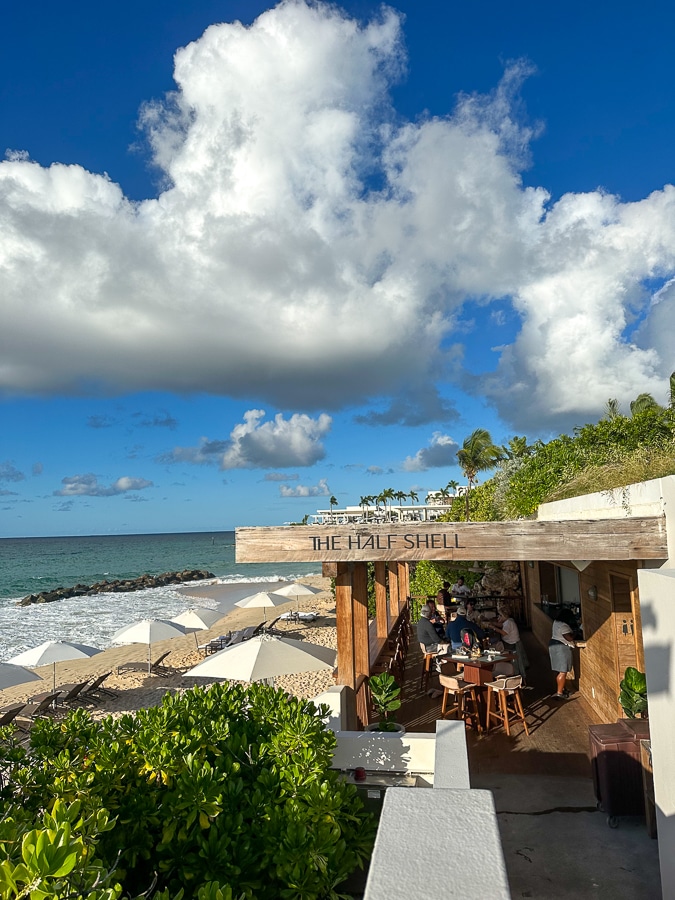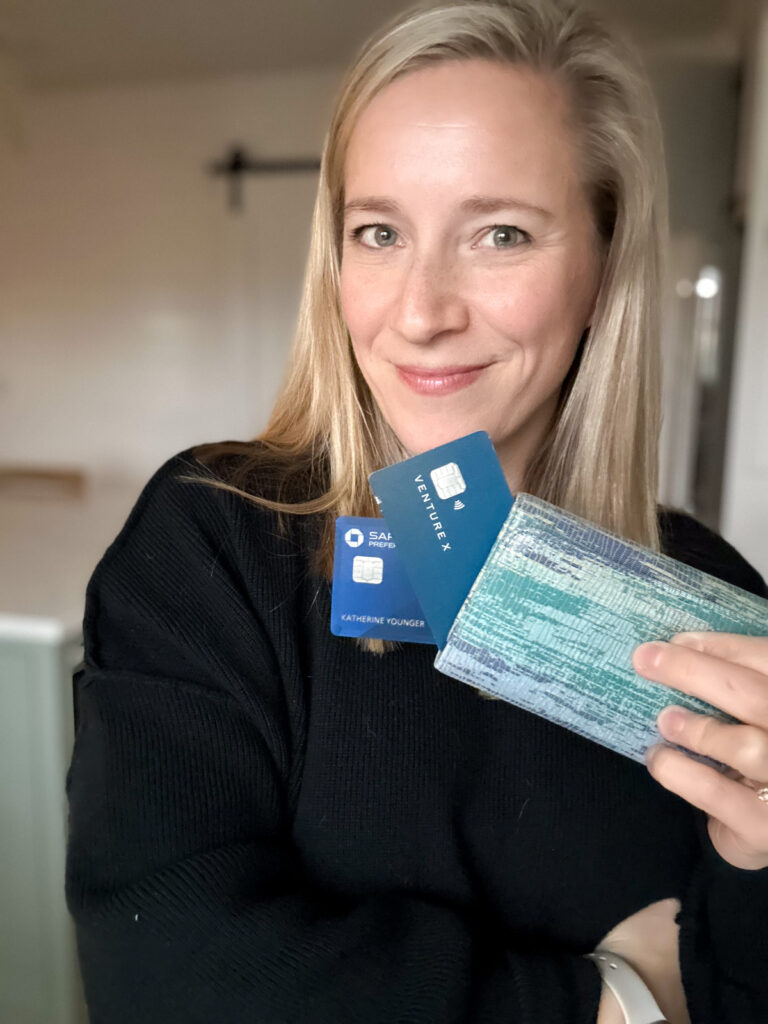Chase vs Capital One Travel Cards: Get Both!
When it comes to travel cards, there are a few that stand out in the mix. Here’s an overview of Chase vs Capital One travel cards and why I have both in my wallet! This post includes affiliate links to the cards I recommend.
Thomas and I should be in Mexico right now at the Andaz Mayakoba! This trip is costing us almost nothing thanks to travel rewards! We paid for our flight and hotel with Chase Ultimate Rewards points (before we left) and we’re paying for our food and drinks (charged to the room) with Capital One Venture Reward Miles. This post will explain how these two points currencies work together to cover travel before and during your trip!
Chase vs Capital One Travel Cards
Whenever I friend asks me about using credit card points to travel for free, I always tell them that ultimately they probably want both a Chase Sapphire and a Capital One Venture in their wallet. While those just getting started are always a little weary of getting multiple new cards, rest assured you don’t need to rush into getting them. You can get one per year and keep them forever as your travel cards.
The main reason I recommend both is because they earn different points currencies and you spend points in different ways. The Sapphire is great for before trips and the Venture is great for on and after the trip.
Premium or Ultra Premium?
Both Chase and Capital One have two levels of their Sapphire/Venture cards:
Which level you get is up to your comfort level of annual fee and how often you travel / how often you’ll use the card. I’m going to focus on the premium level for this post, but know either is an option! The currencies will work together and balance out the same.
Here’s a quick overview of Sapphire vs Venture Rewards:
- Currency: Earns Chase Ultimate Rewards that you can either use to book travel for 1.25 points per dollar in the Chase portal OR transfer to travel partners like Hyatt, Marriott, British Airways, United, and Jet Blue.
- Current bonus offer worth $750: 60,000 Chase Ultimate Rewards Points after you spend $4,000 in the first 3 months
- What to use it on: this card earns 3x points on restaurants, so this is my primary dining out card
- 1x points on everything else
- Currency: Earns Capital One Rewards Miles that you can erase travel with a statement credit with after you travel OR you can book travel in the Cap One portal OR you can transfer to partners like Air France/KLM Flying Blue, British Airways Avios, Choice Privileges and Wyndham Rewards
- Current bonus offer worth $750: 75,000 Capital One Miles after you spend $4,000 in the first 3 months
- What to use it on: everything except dining!
- 2x points on everything else
Both cards have other perks like trip cancellation insurance, perks for rental cars, a $50 hotel credit (Sapphire only), TSA PreCheck credit (Venture only), and a $95 annual fee.
The view at the Four Seasons Anguilla

Booking In The Portals: Chase Wins
Both cards allow you to book in portals and also transfers to their selection of travel partners. In my opinion, Chase wins the portal game because you get 1.25 points per dollar vs. the 1 to 1 with Capital One. Because of this, when we need to book travel – flights, sometimes hotels – we always use Chase! It’s very easy to book in the Chase portal – just search for your hotel or flights and when you check out, you’ll just pay with points. Put any remaining balance on your Sapphire and you’ll earn 5x points on that spend.
If you’re going to transfer points, Chase wins for this too because I’d much rather stay at a Hyatt resort than the hotel choices for Cap One. Travel Freely reports that the value of Chase points go up to about 1.8 when transferring points to travel partners. So you’re getting more than $1 per point. Thus the Chase points are considered very valuable because they are worth so much. That said, it’s a little more complicated to book travel with Chase than with Capital One where you simply erase any travel expenses you incur! See below.
Erase Travel After You Get Home With The Venture
The Purchase Eraser lets you book right on a hotel/airline website and then erase the purchase from your statement with points. That’s ultimate flexibility!
The Venture is also great for all expenses that aren’t the base trip costs: shuttles, rental cars, food and drinks on property, and anything you charge to your room (like a massage!). With the Points Eraser, you will find a list of travel expenses in your Capital One app that you’ve incurred in the past 90 days. You select the ones you’d like to erase, select how many points to put towards it, and BOOM you get a refund on your card in a day or so!
Keep in mind that the expenses need to be defined by Capital One as travel before they can be erased. A few things you might think are travel but aren’t: airport parking and gas. But anything hotel related will be. And I’ve had several shuttles come through as travel (our Disney shuttles, our Mexico shuttles, and the BHI ferry!)
The Purchase Eraser is also key if you love staying at Airbnbs! Anything coded as travel counts – from Airbnb to Uber rides to the Bald Head Ferry. This is a HUGE perk of the Venture X if you love boutique hotels or staying in houses. Here’s an article on using the points eraser.
The Balance: Chase Before + Venture After Travel
I love the balance between accumulating Chase Ultimate Reward points for flights and bigger hotel stays and using my Capital One points to erase smaller travel expenses that I wouldn’t otherwise be able to use points for. Paying for food on trips has always been a drawback to the free travel world because if you’re like us, you can rack up some food and drinks! Sure having your flight/hotel be free might mean you can put more budget towards food, but being able to charge the food to your room and then erase the cost is kind of like staying at an all-inclusive : ) For example, we book our hotel and flights to Mexico in the Chase Portal and then charged all of our food and drinks to our room and used Capital One points to erase that cost! This means our trip was totally free minus a few incidentals!
Lunch at The Half Shell, Anguilla

How To Earn More Points
After you get the initial $750 sign up bonus, there are a few ways to earn more points so you can keep this runway going:
- Refer friends – You’ll get 15,000-25,000 points per friend up to 100k points per year (this varies per card). That’s up to $250 per friend/family member.
- Spend money – Obviously when you use your cards for everyday things you’ll earn money. I’m the friend to drop my card at a restaurant and have people Venmo me back. Gotta earn those points! Remember I use Chase for all things food/groceries and Cap One for everything else because it earns 2x as much as Chase for everything else (medical bills, taxes, subscriptions, Christmas gifts, etc.)
- Mix in business cards – See below! This is the best way to travel a lot if you have a business owner in your family.
Chase + Capital One Business Cards
If you have a business, and the word business is very loosely defined, you can earn even more points. Thomas and I are both business owners, so we have both gotten several Chase Ink business cards and tons of points that way. You don’t need to have a storefront or need a EIN to be considered a business. If you drive for Uber or make jewelry, you have a business. The business cards usually have higher spending requirements to get the sign up bonus, but the bonuses are usually higher too.
Here is the best part: You can transfer your business points to your Sapphire or Venture and then use them for your trips! So because you’re earning the points for buying printer ink for your home office, you can move them to the Venture card and then erase a pina colada you charge to your room on your vacay.
Chase Business Cards
Capital One Business Cards:
More Cards To Get
Chase has a handful of other cards (like the Freedom card) that earn Ultimate Rewards and you can transfer those to your Sapphire. So if you have a Sapphire and a Venture and want to boost your points, you can apply for more cards and then move those points to your primary travel card (since the Sapphire gets that 1.25-1.8 point valuation!)
The Must Have Travel Card App
If you’re starting out in this travel card world, you need the Travel Freely Card Tracker. It’s free to use, and it will tell you a summary of each card’s perks which will help you know which cards to use and when. You can put in the cards you have and it will keep track of your application date, annual fees, and when it’s time for a new card. The card genie is also a nice perk to recommend which card to get next. You can also put in personal and business to best stagger those as well.
What About Amex?
I have yet to dabble in Amex, so I can’t speak much to how it would fit into this plan. If and when I feel that we’re low on points and could use a boost, I may work my way into the world of Amex. I’ve heard the Amex Gold is a very good card. If you’re already tapped into Amex family of points, you can see the best offers for Amex cards here.
In Summary
- Before a trip: Use all cards that earn Ultimate Rewards to pool points to the Sapphire and book flights and hotels either in the portal or transfer to partners
- After a trip: Use your Capital One points to erase food, drinks, and transportation costs you incurred during your trip!
- Apply for a Chase Sapphire Preferred here
- Apply for a Capital One Venture Rewards Card here
- Consider getting the Chase Sapphire Reserve or Capital One Venture X too! (I have the Venture X and love the extra perks that come with it like lounge access).

Where are you traveling first!?
More travel rewards posts:
from Kath Eats https://ift.tt/tkrvmpA
Comments
Post a Comment